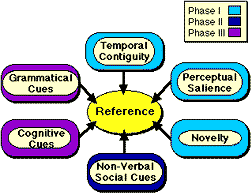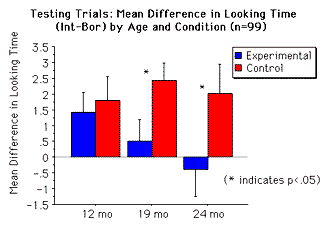|
[ Abstract - Introduction - Hypothesis - Method - Results - Discussion ] |
|
|
|
[ Abstract - Introduction - Hypothesis - Method - Results - Discussion ] |
The rate of early word learning increases dramatically from 12 months to 19 months of age. To explain this shift, we adopt an Emergentist Coalition Model, asserting that word learning principles are the product, not the engines, of development. As a case in point, we hypothesized that the Principle of Reference might develop from an immature to mature state, moving from pure perceptual association to a reliance on social cues for word learning. Results suggest that 12-month-old infants do rely heavily on perceptual salience when attaching a label to an object, while 19- and 24-month-old infants preferentially follow social eye gaze in the service of word learning. Thus, infants appear to move from a child-oriented perspective to a speaker-oriented perspective, from assuming that the label merely "goes with" an object to realizing a novel label's true symbolic function.
The character of early word learning changes dramatically within the first two years of life. Instead of the slow, laborious progression of 12-month-olds, by 19 months of age, children are learning approximately nine new words a day. To accomplish this feat, older infants appear to make use of fairly sophisticated assumptions or principles concerning the nature of the mappings between linguistic sounds and the objects, actions, and events in their environment.
However, it is not known where these principles have their origins or how they develop. Consider "The Principle of Reference." Reference forms when children realize that words "refer," i.e., words have a symbolic, communicative meaning. Compelling evidence for this principle is provided by Baldwin (1993), who demonstrated that during labeling, 19-month-old infants spontaneously check the direction of adult eye gaze to attach the label, rather than linking that label to the object that was previously the child's focus of attention. This implies that, at least by 19 months, children realize the symbolic, communicative intent of language. That is, they have a mature Principle of Reference.
To explain the origins and development of principles, like Reference, we adopt an Emergentist-Coalition Model. This model has the following three properties.
|
1) Multiple Cues: Social, Cognitive, and Perceptual, all interact to permit early word learning. (Nelson, 1996) 2) Differential Weighting of cues with time. (Baldwin, 1993) 3) Emergent: Principles are thus the products not engines of development. (Bloom, 1993; Karmiloff-Smith, 1993) |
 |
In the following studies, we begin to test the Emergentist-Coalition Model by a focused investigation of the Principle of Reference, examining whether the development of Reference follows the three properties of the model listed above. That is, does Reference depend on multiple cues and differential weighting of those cues, and is it, in this manner, emergent?
Specifically, Reference is hypothesized to move from a child-based attention for perceptual cues to a more mature speaker-based principle capitalizing on social cues, like eye gaze, in the service of word learning (Golinkoff, Mervis, Hirsh-Pasek, 1994; Baldwin, 1993). Thus, when perceptual and social cues are placed in conflict, younger, 12-month-old infants, should follow perceptual salience while 19-month-old infants should follow eye gaze in the service of labeling.
|
|
In order to test our hypothesis, it was necessary to create a new method which would allow us to study, within the laboratory, both children's labeling abilities, and, as a consequence, their comprehension. To accomplish this, we used a modified version of the Intermodal Preferential Looking Paradigm developed by Hirsh-Pasek and Golinkoff (1994). The new 3-D Intermodal Preferential Looking Procedure uses the infant test board developed by Fagan (1968), and is based on the design of Baldwin's (1993) bucket task.
The general design consists of alternating familiar and novel trials. In the familiar trials, children explore two familiar objects (e.g., a book and a ball). The objects are then placed side by side on the Fagan board which flips over (allowing for controlled exposure time), and the child is asked to look at one of the objects. Similarly, in the novel trials, children explore two novel objects. Then, these objects are presented on the Fagan Board for a salience phase in which both objects are shown but not requested. Next, in the training phase, one of the toys is labeled (five times) via social eye gaze. Acquisition of this label, is then assessed in the testing phase, in which the toys reappear side-by-side on the board while one is requested.
|
Familiar Trials
|
Novel Trials
|
|
The logic of the experiment, as in other preferential looking tasks, is that the child will look longer at the toy that matches the requested object than at the toy that does not match. The dependent variable is looking time while the independent variables are age, salience, and direction of eye gaze.
19- and 24-month-old infants did look longer at the boring object when it was labeled through social eye gaze. In contrast, 12-month-old infants did not.
|
Boring |
Boring |

In Study 2, when a new (untrained) label was requested, 12-month-old infants now looked longer at the boring object, indicating that the specific label does make a difference.
|
|
|
|
Although the Emergentist Coalition Model is in it's infancy, the research presented here attempts to show how this model can account for the origins and development of a fundamental lexical principle: Reference. 1) Multiple cues are indeed available: The results indicate that infants pay attention to both perceptual and social cues. 2) The weighting of these cues changes over time: 12-month-olds are swayed by perceptual salience while 19- and 24-month-olds are not. 3) In this manner, reference is emergent, a product, not the engine of development. |
In addition, we have developed a new method that works with 12-month-olds and allows for controlled investigation of word learning cues at the microscopic level. Finally, with the Coalition Model, we have attempted to synthesize the conflicting positions inherent within the literature. In Woodward and Markman's (1997) recent review of early word learning research, they argue that none of the proposed solutions for the word learning problem are sufficient to explain how children acquire their first words. Rather, "word learning depends on an ability to recruit and integrate information from a range of sources" (p.1). In the Emergentist Coalition Model, we have tried to take this challenge seriously, and to provide a new way of looking at the word learning problem. |
|
Coments to: ghollich@yahoo.com |
Last Modified: Sept 20, 1999 |